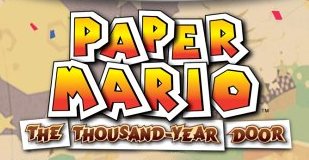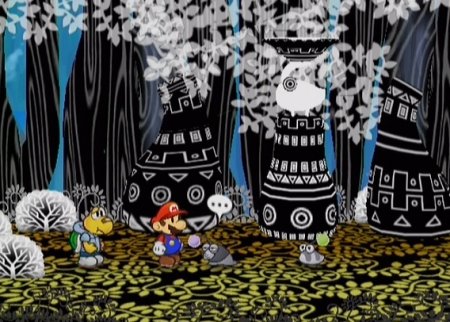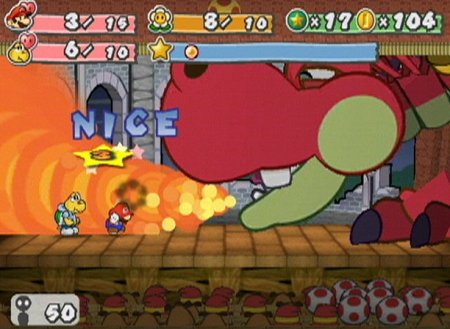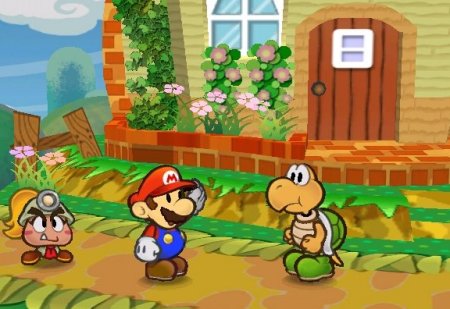Developer: Intelligent Systems, Nintendo
Platform: Gamecube
Genre: JRPG

Warning: In this review I may use the word ‘juxtaposition’. Please treat it accordingly.
Taking an existing franchise into a different genre is always a risky proposition. Fortunately for developers Intelligent Systems, Squaresoft made this particular leap for them 8 years prior with the magnificent Super Mario RPG for the SNES. The original Paper Mario came out towards the end of the N64’s life, and no-one really played it despite it being critically acclaimed. I recently played through the version on the Wii Virual Console, and can highly recommend it to anyone who thinks they can stomach playing an N64 game in this day and age.
Paper Mario is a weird idea in itself. In these games, the characters and large portions of the scenery are apparently made of paper. The original game didn’t do much with this idea, but they’ve totally taken it to the next level here. By that I mean that Mario can turn sideways, into a tube, and occasionally he turns into a paper aeroplane or boat. Great stuff. I’m really not sure at how the ended up at the idea of having Mario made of paper, no seriously what the hell was the thought process behind that? The only thing I can possibly think was that it had something to do with developing a simple art style that the N64 could handle.

It’s best not to ask really. Looks nice though.
With the additional power of the Gamecube the character detail has been improved a lot, so the camera can zoom right up close without them going all pixely and crappy looking. I could hardly say that this game pushed the graphical capabilities of the Gamecube particularly hard, but it doesn’t need to. The art style works, and it’ll probably still look passable in a million years if you’ll forgive my hyperbole.
Mario RPG games always start in Mario and Luigi’s house. Yes, for some reason they share a wooden house, and sleep on bunk-beds. I guess it makes sense. Anyway, Mario gets a letter from Princess Peach inviting him to come and assist her in a far off city. Mario dutifully rushes off to the city called Rogueport which serves as the game’s main hub (it is a port with rogues in it, if the name wasn’t clear enough). Once there he discovers Princess Peach has been kidnapped. If I were Mario I’d just assume that if she left my field of view for any period of time then she’s probably already totally kidnapped. While attempting to find her, Mario ends up trying to unravel the mystery of a giant door beneath Rogueport. This adventure sends him off all over the world to find 8 brightly coloured thingymabobs that’ll will apparently open the door once collected.
Much of the charm of the game comes from the juxtaposition of having cutesy mario creatures in an actually well realised and slightly dark game world. Rather than in other mario games where a koopa’s soul job is to walk along a path, here you meet a koopa who is trying to overcome his cowardly nature, and having a hard time with his girl-friend. Rather than being stomped on by Mario and blown up as usual, you meet a bob-omb who is in mourning for his deceased wife. These oddly realistic situations are forced on cute characters to hilarious effect, and overall it’s extremely effective in making the mario universe, such as it is, a rich enough backdrop to have an RPG on.

Some of the bosses struggle to fit onto the battle stage.
Combat in the Paper Mario games is a turn based jrpg style affair. Unusually for a jrpg though, the numbers involved are really small. An enemy will likely have less than 15 HP, and your normal attacks will do 1-8 damage or so as the game goes on. This makes a welcome change from the meaninglessly inflated values of recent Final Fantasy games, where the hardest boss has 50 million HP, rather than the mere 200 HP in this game. Most of the actions you take in combat have some sort of skill test that if you do correctly will make the attack more powerful, or an enemies attack less powerful. This usually involves hitting A at the exact moment the animation of the attack connects with the enemy. If you are feeling risky, you can defend using the B button which not only negates all the damage of an enemie’s attack, but actually does some damage back to the enemy. This is appropriately hard to pull off, but very good when you do get the timing down. Every enemy’s attack has different timing, and a lot of the attack animations are designed to confuse you as to exactly when the damage is going to occur.
A new aspect to the combat is that the combat scenes take place on a theatrical stage, in front of an audience. The stage is dressed with a rough impression of the area you were in before, but obviously done like stage backdrop. If you do impressive moves, you will win over more members of the audience, who throw crap at whichever side they don’t like, sabotage the stage dressing, and occasionally get eaten by the more ferocious enemies. This doesn’t add an awful lot to the combat as the things they throw do very little damage. It is fun to hear the roar of the crowd when you pull of an impressive move though. As you progress through the game the stage becomes more elaborate, and eventually gets wrestling-style fireworks going off at the start of each battle.

This koopa may look all cutesy, but he’s probably worried about his mortgage repayments.
As you progress through the game Mario gets seven different companions who are roughly gender swapped versions of the companions from the first game. There is a Goomba, a Bob-omb, a Koopa, a Yoshi, and some other random ones. These party members participate more in the combat now, and have their own HP, which has made the combat a bit deeper. Outside of combat you can have one selected at once, and they will do all the talking for Mario who is largely mute as always. They have written unique conversations depending on which companion you have for some of the game, which is a nice touch.
There are 8 main chapters in the game, each concerned with Mario recovering one of the 8 thingumies he needs to open the door. Structurally, you usually have to go to a new town, then onto a dungeon where you will face a boss. One of the chapters mixes things up by having you have to work your way up through a fighters arena to claim the champion’s belt which has the needed thingy attached to it. This overall structure hasn’t varied massively from the first game.
Also carried over from the previous game are the intermissions between each chapter. During thse you take control of Princess Peach as she explores the weird futuristic base where she has been captured, and befriend a creepy computer who develops a crush on her after watching her take a shower. This game also adds a second sequence between each chapter where you get to play as Bowser. Bowser is annoyed that it isn’t him who has kidnapped the princess this time, and is following Mario around trying to work out what the hell is going on, which results in him constantly turning up too late to get anything done. These sequences are hilarious, and as a bonus it occasionally cuts to a Super Mario Bros. style side-scroller sequence where you control Bowser, and smash your way through World 1-1 of the original Mario.

“Have some of this!”
If I had to find criticism with the game, I would suggest that the side quests involve slightly too much tedious backtracking. These side quests come from a job board that gets a few jobs added to it each chapter, buy they invariably involve revisiting a ton of previous locations for very little reward. Another annoying aspect is that certain enemies can lock you in to a stun cycle. There are these flowers-enemies that cast ‘Sleep’ on you every turn unless you can hit a very hard defend move, and the sleep lasts for 2 turns. It doesn’t take a genius mathematician to see the problem with this. I’d also say that the mana/flower points are largely useless due to not enough ways to refill them. I’d advise anyone starting the game to only ever upgrade their Badge Points and HP when they level up.
Overall the game is probably slightly worse than the original. It copies the formula almost exactly so comes off as a sort of retread with better graphics. I’m glad they chose to mix up the formula as much as they did with Super Paper Mario, which I will presumably get around to playing now that I have finished the first two games.
Arbitrary Rating: 9 – Mario è fatto di carta
Recent Comments